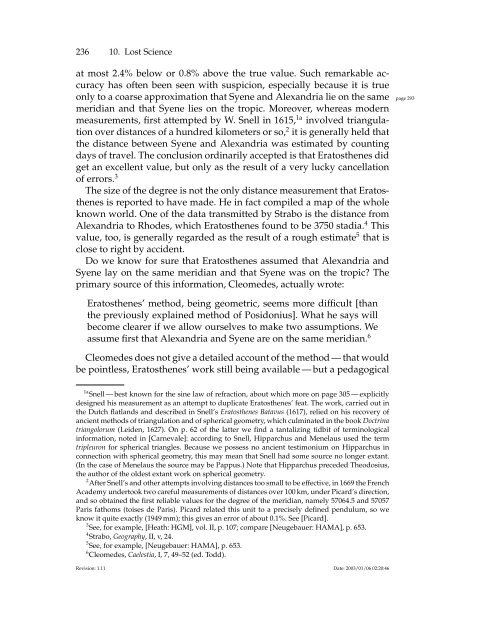1 The Birth of Science - MSRI
1 The Birth of Science - MSRI
1 The Birth of Science - MSRI
Create successful ePaper yourself
Turn your PDF publications into a flip-book with our unique Google optimized e-Paper software.
236 10. Lost <strong>Science</strong><br />
at most 2.4% below or 0.8% above the true value. Such remarkable accuracy<br />
has <strong>of</strong>ten been seen with suspicion, especially because it is true<br />
only to a coarse approximation that Syene and Alexandria lie on the same page 293<br />
meridian and that Syene lies on the tropic. Moreover, whereas modern<br />
measurements, first attempted by W. Snell in 1615, 1a involved triangulation<br />
over distances <strong>of</strong> a hundred kilometers or so, 2 it is generally held that<br />
the distance between Syene and Alexandria was estimated by counting<br />
days <strong>of</strong> travel. <strong>The</strong> conclusion ordinarily accepted is that Eratosthenes did<br />
get an excellent value, but only as the result <strong>of</strong> a very lucky cancellation<br />
<strong>of</strong> errors. 3<br />
<strong>The</strong> size <strong>of</strong> the degree is not the only distance measurement that Eratosthenes<br />
is reported to have made. He in fact compiled a map <strong>of</strong> the whole<br />
known world. One <strong>of</strong> the data transmitted by Strabo is the distance from<br />
Alexandria to Rhodes, which Eratosthenes found to be 3750 stadia. 4 This<br />
value, too, is generally regarded as the result <strong>of</strong> a rough estimate 5 that is<br />
close to right by accident.<br />
Do we know for sure that Eratosthenes assumed that Alexandria and<br />
Syene lay on the same meridian and that Syene was on the tropic? <strong>The</strong><br />
primary source <strong>of</strong> this information, Cleomedes, actually wrote:<br />
Eratosthenes’ method, being geometric, seems more difficult [than<br />
the previously explained method <strong>of</strong> Posidonius]. What he says will<br />
become clearer if we allow ourselves to make two assumptions. We<br />
assume first that Alexandria and Syene are on the same meridian. 6<br />
Cleomedes does not give a detailed account <strong>of</strong> the method — that would<br />
be pointless, Eratosthenes’ work still being available — but a pedagogical<br />
1a Snell — best known for the sine law <strong>of</strong> refraction, about which more on page 305 — explicitly<br />
designed his measurement as an attempt to duplicate Eratosthenes’ feat. <strong>The</strong> work, carried out in<br />
the Dutch flatlands and described in Snell’s Eratosthenes Batavus (1617), relied on his recovery <strong>of</strong><br />
ancient methods <strong>of</strong> triangulation and <strong>of</strong> spherical geometry, which culminated in the book Doctrina<br />
triangolorum (Leiden, 1627). On p. 62 <strong>of</strong> the latter we find a tantalizing tidbit <strong>of</strong> terminological<br />
information, noted in [Carnevale]: according to Snell, Hipparchus and Menelaus used the term<br />
tripleuron for spherical triangles. Because we possess no ancient testimonium on Hipparchus in<br />
connection with spherical geometry, this may mean that Snell had some source no longer extant.<br />
(In the case <strong>of</strong> Menelaus the source may be Pappus.) Note that Hipparchus preceded <strong>The</strong>odosius,<br />
the author <strong>of</strong> the oldest extant work on spherical geometry.<br />
2 After Snell’s and other attempts involving distances too small to be effective, in 1669 the French<br />
Academy undertook two careful measurements <strong>of</strong> distances over 100 km, under Picard’s direction,<br />
and so obtained the first reliable values for the degree <strong>of</strong> the meridian, namely 57064.5 and 57057<br />
Paris fathoms (toises de Paris). Picard related this unit to a precisely defined pendulum, so we<br />
know it quite exactly (1949 mm); this gives an error <strong>of</strong> about 0.1%. See [Picard].<br />
3 See, for example, [Heath: HGM], vol. II, p. 107; compare [Neugebauer: HAMA], p. 653.<br />
4 Strabo, Geography, II, v, 24.<br />
5 See, for example, [Neugebauer: HAMA], p. 653.<br />
6 Cleomedes, Caelestia, I, 7, 49–52 (ed. Todd).<br />
Revision: 1.11 Date: 2003/01/06 02:20:46










